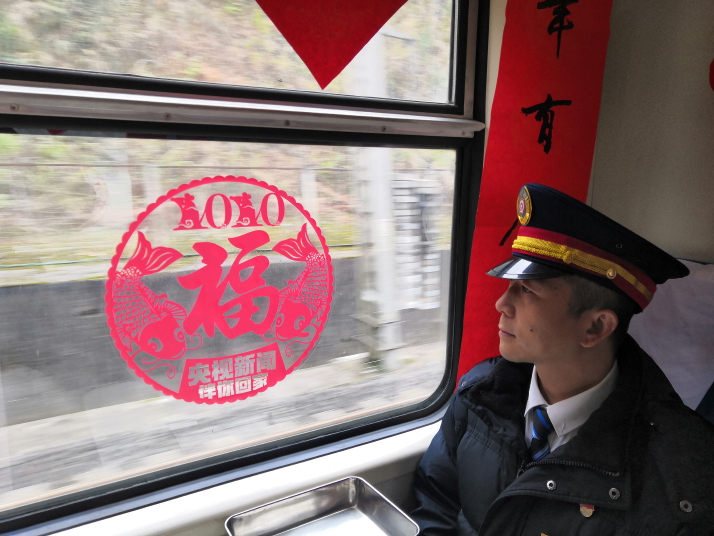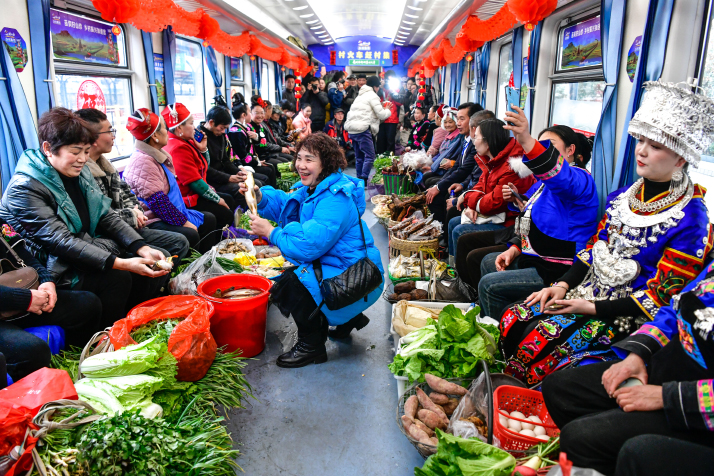| China |
| Sales on rails | |
|
|
 Hu Guichuan, a conductor, on a slow train in 2020 (COURTESY PHOTO)
Green-painted trains, relics of the days before high-speed rail, have become vessels of nostalgia for many in China. Representing a slower pace of life, they continue to rumble across the vast landscape, serving tourists seeking unhurried journeys and remote communities not yet accessible to the modern rail network. One pair of these, train 5640/39 linking Yuping Dong Autonomous County in the far east of Guizhou Province and the provincial capital Guiyang, is not only a means of transport for rural residents, but also a high-spirited mobile marketplace, thanks to the ingenuity and dedication of one of its conductors. Hu Guichuan, in his 40s, has been a train conductor for 28 years. Born in Kaili, one of the stops along the route, he traveled on 5640/39 as a child before becoming a member of its crew. He told Beijing Review that the 337-km, 16-stop train line links more than 100 ethnic minority villages and, because of its low fares and proximity to farming communities, it remains the most popular option for travel. "Even now, with roads available, villagers still prefer the slow trains and don't want them to stop running," he said, adding that the fare between two stations can be as low as 6 yuan ($1) and that passengers can buy tickets even after getting aboard. With many young people leaving villages to find work in urban areas, those left behind, often elderly, depend on the slow train to transport their produce to market. To help them sell their goods, Hu had the idea in 2016 to establish a market on the train and dedicate one carriage to doing so. The carriage is now a dynamic marketplace, offering goods including seasonal fruit and vegetables and freshly caught fish, which often sell out before reaching their destination. The rhythmic sound of the train now blends with the lively chatter of bargaining and the melody of folk music, making the train more than just a mode of transportation. A mobile market "Elderly villagers are thrilled to earn a few bucks with which to buy daily necessities," Hu said. However, they often sell their produce too cheaply as they don't have access to information on market prices. To help address this, Hu began visiting local markets and restaurants during his breaks to gather information on general market prices. He displays this price information on a bulletin board and broadcasts it over the announcement system, helping villagers negotiate better deals. He also carries a notebook with him at work, writing down passengers' goods and volumes and passing the information on to merchants. Guizhou is one of the poorest regions in China, known for its rugged terrain and rainy weather. It is also one of the few regions in the country that lack flat arable land. But over the past decades, its fight against poverty has gradually seen yields. Slow trains are part of the progress. The slow trains have become a lifeline for many local people living along the route. "The villagers, once mired by poverty, now live in better homes, and their earnings are improving," Hu said. Jin Yunlong who lives in Ganba Village in Kaili, often takes the slow train to sell agricultural produce at fairs in the city's downtown area. His family's annual income from selling vegetables and chickens has reached 100,000 yuan ($13,808) in recent years.  Villagers sell goods on train 5640 in Guizhou Province, southwest China, on January 18 (XINHUA)
Journey to a better life The slow trains are also no longer just for locals, with a growing number of tourists attracted by the scenic views along the route and the opportunity to purchase fresh produce and experience the Miao culture. The Miao ethnic group, one of the largest ethnic minorities in southwest China, has maintained their distinctive customs and cultures, which date back centuries. Many tourists have also been attracted to sporting events in Guizhou's rural regions, including the Village Super League soccer tournament and Village Basketball Association games. "The number of tourists has been surging in recent years, especially during summer holidays," Hu said. Beginning in 2018, the two slow trains that service the route have been upgraded with air-conditioned carriages and improved facilities, he said. In 2019, the route introduced its first Spring Festival Store, offering villagers celebratory merchandise like snacks and toys at discounted prices. During the Spring Festival (Chinese New Year) holiday from January 28 to February 4 this year, the slow trains continued running, with new carriages added for displaying and selling intangible cultural heritage crafts of the Miao people, including batik, embroidery and silverware. Passengers also enjoyed performances of Miao-style dances and instruments. Guizhou Village T, a unique fashion show originating from rural areas, particularly in Guizhou, made its way to the slow trains this year. The models, including professional ones and local villagers, have performed in many countries like Canada and Finland. They have jointly showcased traditional Miao attire and merged elements of Miao songs, embroidery, farming tools, and specialties into the shows on slow trains. After the holiday, Hu returned to his work for the second half of the busy inter-regional Spring Festival travel rush that is running from mid-January to February 22 this year. "More tourists will take the slow trains to scenic spots in villages and towns along the routes," Hu said. While continuing to serve villagers, he and other train crew members continue to focus on enhancing services for these tourists. Hu said he believes that although high-speed trains are increasingly the norm in China, slower trains better facilitate the life of passengers in remote areas with the low fare that is largely affordable. The slow trains are actually not slow in speed but stop at every station to make travel of local passengers more convenient. "The slow trains that have operated for decades will continue to run," he said. BR Copyedited by G.P. Wilson Comments to lixiaoyang@cicgamericas.com |
|
||||||||||||||||||||||||||||
|